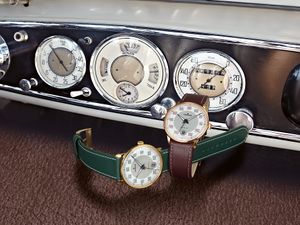Junghans: A watch for gentlemen
Press release
Schramberg, February 2017




A watch for gentlemen
The new Meister Driver Automatic allows a journey in time, to when car travel was still a stylish adventure.
Reminder of a golden age
A very special atmosphere prevails in the evening, when the drivers gather in the country house. In the venerable library and comfortable lounge the drivers discuss the challenges of the race track. The cars that they have pushed to their limits that day stand in the driveway. British Racing Green is the predominant colour. It symbolises the historic sportiness of the racing cars like no other. It is these automobiles, with their traditional colours, that served as models for the design of the new Meister Driver Automatic – and bring this era back to life.
Sophisticated nostalgia
The new Meister Driver Automatic embodies the age when car driving was the preserve of the adventure-loving gentleman – with a leather cap and driving goggles. The gold-coloured case in combination with the traditional colours green and brown lends a particular class to the timepiece. The large minute markers on the dial stand out clearly. The grand, rectangular minute digits replace the familiar hour markers, becoming the distinguishing element on the dial. They are filled with luminous material, thus reflecting the technical character of the automobile timepiece. Black Dauphin hands ensure good legibility and a whiff of nostalgia. Also in black is the date on the two-tone dial, which is refined with polished lacquer. As befits the legendary racer for the wrist, the perforated underlayer of the strap is based on the seats of classic historical cars – the next excursion beckons.
Junghans Meister Driver – passion and the pioneering spirit
The strong links between Junghans and the automobile have been in place since the end of the 19th century. Arthur Junghans, son of the company founder Erhard Junghans, was a close friend of Gottlieb Daimler and Wilhelm Maybach. As a consequence, he bought one of the first Daimler test cars in 1892. Just three years later Arthur Junghans ordered a four-seater Motor-Viktoriawagen, for which he created worm gear steering. At the beginning of the 20th century the company produced car clocks. Numerous inventions were also made – in 1905 Dr. Oskar Junghans, son of Arthur Junghans, developed a speed measuring device with integral speed logging. His brother Helmut shared his passion for the automobile. In 1924 he developed a "Viadicator" driving direction indicator in co-operation with the Leitz company of Wetzlar, a predecessor of the present-day indicator. More than a century of affinity for the automobile is continued today by the Junghans owners, Dr. Hans-Jochem and Hannes Steim. The Steim car collection in Schramberg, which celebrates its 10th birthday in 2017, contains a cross section from over 110 years of automobile history – with stylish classic vehicles that serve as inspiration for the models of the Meister Driver series, bringing this passion to the wrist.
Junghans – The German watch
Junghans was founded in the Black Forest town of Schramberg in 1851. Over 150 years of expertise in precision and design is reflected in memorable milestones: In 1093 Junghans was the largest watch manufacturer in the world, with over 3,000 employees. The development of precision movements made the company the largest German manufacturer of chronometers in 1951 and the third largest worldwide in 1956. In 1972 Junghans was the official timekeeper of the Olympic Games in Munich, setting new standards in timekeeping. After an eventful and turbulent company history, the Schramberg entrepreneurs Dr. Hans-Jochem and Hannes Steim became the new owners of the venerable company in 2009. Each watch is produced in Schramberg with great attention to detail, technological expertise and high standards of design and quality. The collection comprises charismatic timepieces: The Meister watches, which have been produced since the 1930s, reflect the history and present of the company. In 1956 Max Bill designed watches that have become absolute classics. Distinguished by the Bauhaus philosophy, they are still produced today in nearly unchanged form. Junghans set new standards in 1990 with the invention of the radio-controlled wristwatch – a technology that is still used today, in combination with environ-mentally-friendly solar power. A wide variety of technology as unique as the watches bearing the star.